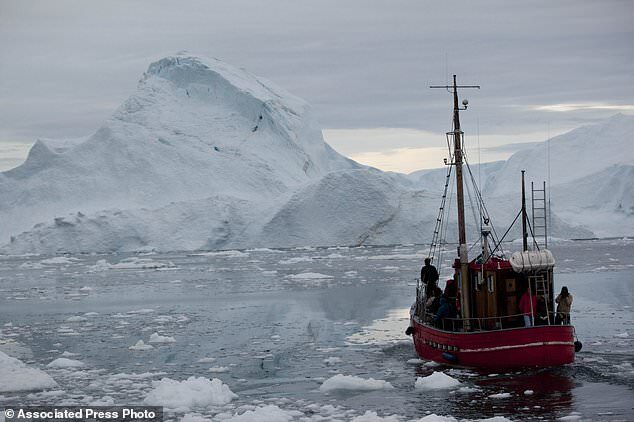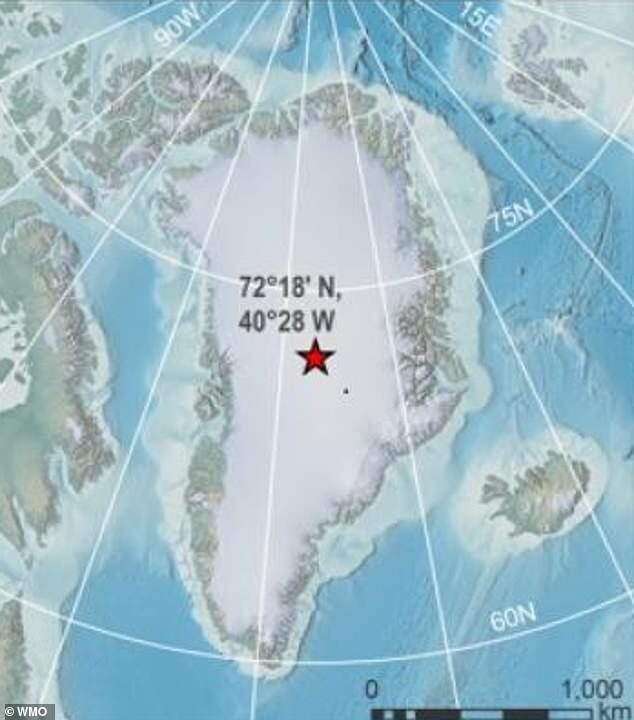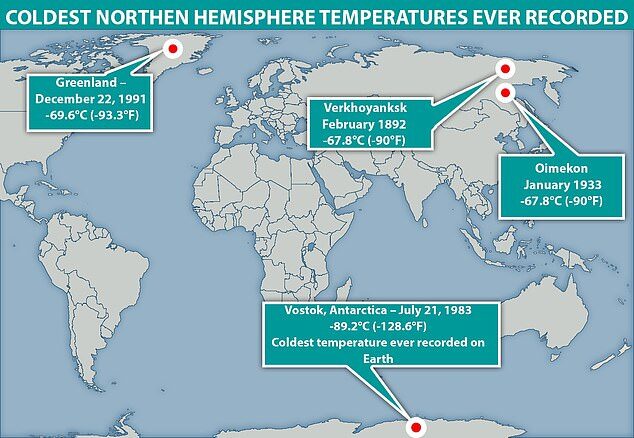
An automated weather station positioned more than 10,000 ft above sea level and atop the Greenland ice sheet took the measurement on 22 December 1991. The temperature sunk as low as -69.6°C (-93.3°F) at the site, located in a frigid place called Klinck, the World Meteorological Organization (WMO) says.
The temperature sunk as low as -69.6°C (-93.3°F) at an automated weather system, located in a frigid place called Klinck atop the Greenland ice sheet

The latter Russian site made headlines in recent months for recording a new record-high temperature north of the Arctic Circle during a heatwave in the region. On June 19 2020 it is believed to have reached 100.4F (38C) in Siberia, an astonishing 32F (18C) above the normal level for this time of year.
The coldest temperature ever recorded on Earth was -89.2°C (-128.6°F) recorded in 1983 at the high-altitude Vostok weather station in Antarctica.
'In the era of climate change, much attention focuses on new heat records,' said WMO Secretary-General Professor Petteri Taalas in a statement.
'This newly recognised cold record is an important reminder about the stark contrasts that exist on this planet.'
The automated weather site at Klinck was set up in the early 90s and operated for two years. It was designed to form part of a network to record the meteorological conditions around the Greenland Crest during the Greenland Ice Sheet Project. As a result, it was deliberately installed as close to the summit of the desolate ice sheet as possible.
In 1994 it was returned to the laboratory for testing and then sent for use in the Antarctic.
The new temperature record surpasses the -67.8°C recorded twice at Siberian sites of Oimekon in 1933 and Verkhoyanksk in 1892. The latter Russian site recorded a new record-high temperature north of the Arctic Circle in June (pictured)
All components of the Automatic Weather Station were chosen because they are able to function in extremely cold conditions, according to George Weidner, who helped design the station.
'On Greenland, all of the sites were installed by snowmobile. So the Automatic Weather Station had to be packed to survive a traverse over very rough snow surfaces,' he said.
'Years of packing experience in Antarctica helped us keep our Automatic Weather Station safe and snug on the sleds being pulled by the snowmobiles,' he said.
But the readings from the station went under the radar, as the body which tracks heat records, the WMO Archive of Weather and Climate Extremes, only formed in 2007.
The new low was discovered by so-called 'climate detectives' working with the WMO's Archive of Weather and Climate Extremes in Geneva.
They pored over reams of historic data in search of records like high and low temperatures, greatest rainfall, and even 'heaviest hailstone' and 'longest lightning flash.'
After spotting the extremely cold temperature, the team tracked down the scientists who initially installed and operated the station, from the University of Wisconsin-Madison.
Independent experts assessed the data, which was said to have been immaculately recorded and kept, the weather of 1991 and the panel unanimously recommended acceptance of the observation as valid.
'This investigation highlights the ability of today's climate scientists to not only identify modern climate records but to play 'climate detective' and uncover important past climate records — thereby creating a high-quality long-term record of climate for climate-sensitive regions of the world,' said Professor Randall Cerveny, Rapporteur of Climate and Weather Extremes for WMO.
The full findings are published in the Quarterly Journal of the Royal Meteorological Society.




Comment: More from EurekaAlert: